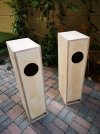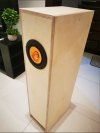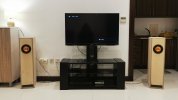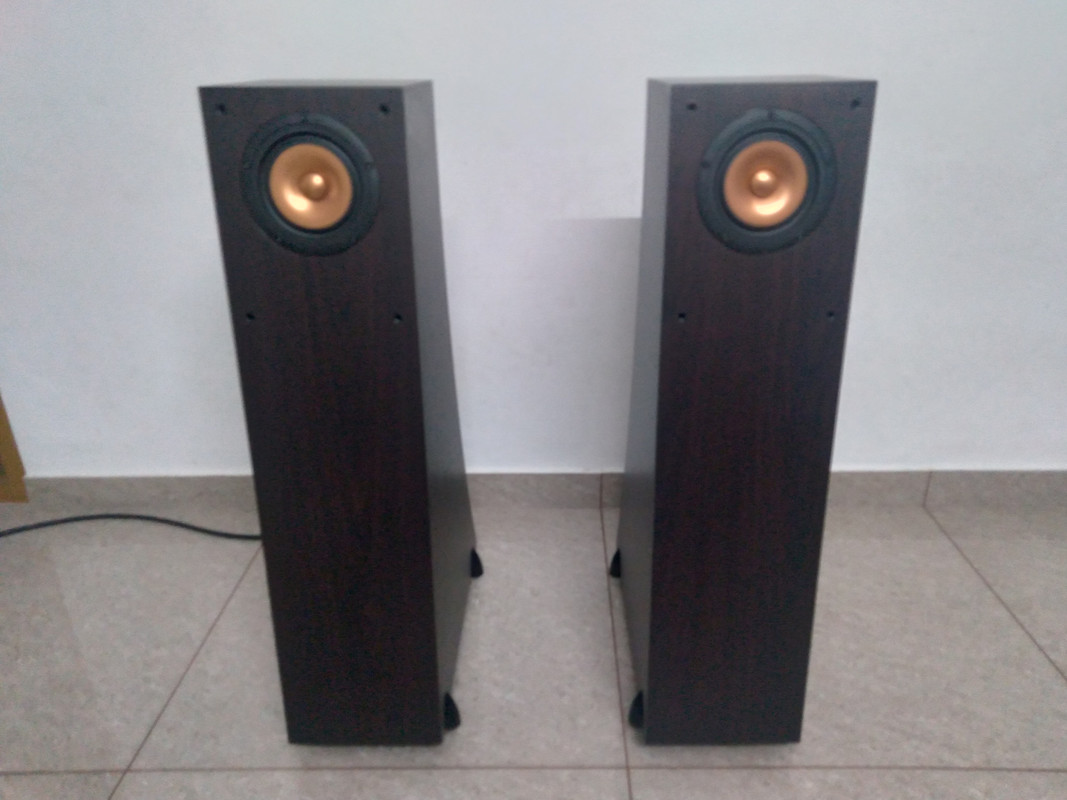Berlyassocial
Active Member
This is a review of Pensil 11 with Alpair 11ms. It's based on untreated room measurements taken using MiniDsp UMIK-1 and REW software. so measurements will vary from my listening room to yours.
BUILD
So let's start from the build itself. The cabinets were build using 18mm baltic birch ply in Abudhabi. I sourced the plywood myself and hired a carpenter to cut and join. The entire process probably took like 3-4hours and the cabinets were ready. I opted for the native finish of birch ply and did not put any veneer, polish, or vinyl coating. So overall i would rate this cabinet as EASY to build as there are no angles or curves involved. The cut pieces were joined using nailgun and fevicol and finished with putty on all joints to enhance sealing. If you have a table saw you can cut and join these pieces yourselves.
The stuffing was done myself using polyfill used for sofa (less springy and slightly higher mass than pillow fill) and thick jute felt is lined only around the vicinity of the driver on opposite sides to reduce early reflections.
I've used around 400g of Polyfill per cabinet.
After mounting the drivers and running them in for a few days I started measuring and assessing the speakers.
BASS
The in-room response of the pensil 11 extends as low as 40hz in a reasonably linear manner and then drops off steeply. So for music listening, I would say there is an ample amount of bass for your demands. The bass coming from these speakers is very fast and accurate which means it doesn't sustain and keeps going like a 12-inch woofer in a vintage 3 way. Some people might like it but some may not. This property of Alpair 11MS is very good when you listen to songs with fast plucking bass guitar notes.
MIDRANGE
Midbass when it comes to vocals is more in a neutral manner and around 400hz there is an inherent dip in the response which was a bit more exaggerated when I took the measurements in my room. This dip shows in the official response published as well.
I did momentarily correct the dip using parametric EQ and listened to many songs intermittently switching the EQ on and off. From these listening sessions, I observed that even though the dip is very evident in objective measurements, it's not really noticeable when listening to music subjectively. Maybe the content in most music at 400hz to 600hz is not so significant. Just an assumption.
TREBLE
Speaking of treble these speakers do perform very well at high range if you know how to place it. This needs a bit of explanation.
If you look into the official frequency response of Alpair 11MS you would notice that the high-frequency response looks to be on the bright side. So naturally, end users might think that these would be bright-sounding speakers once built. But that's not the truth. When looking into this you have to consider a few other elements.
The official frequency response data published is taken ON-AXIS with the driver mounted on a theoretically infinite baffle (ie a huge square baffle). Due to the huge baffle area, the high frequencies are reinforced. But this advantage high frequencies get is reduced when you mount the drivers on a narrow baffle like the pencils or frugal horns. So this alone decreases high-frequency response in a practical scenario.
Also, you have to take into account the fact that it's an ON-AXIS measurement which means the measurement mic is in line with the driver. But when we look into an end-user scenario none of us listen to music placing drivers right in front of our head. instead, sound from the driver arrives at our ears at an angle.
The result of these two phenomena is that when kept facing straight the pencil 11 with alpair 11ms sounds a bit dry without much sparkle to the sound. solution..? just toe-in a little bit towards you and the problem is solved. but don't toe-in like 45 degrees because if you do that the speakers sound similar to what official specs show ie very bright.
SOUNDSTAGE
As you may know, the main aspects affecting the sound stage are cone area, baffle area, and driver matching.
Since it's a full-range driver with an 11cm diaphragm the sound radiating area is very less compared to conventional 3ways and tower speakers. hence these fairly disappear into the listening space.
Staging is further enhanced by the comparatively low width baffle of pensil 11 and optional is that you can bevel the edges of the baffle to further reduce baffle diffraction.
Usually, baffles reflects a lot of high range frequencies in conventional loudspeakers. The wider the baffle the less usually the sound stage is because it becomes easier for our ears and brains to distinguish where the speakers are in the listening area as the sound appears to be coming from a large source. That's why some speakers with large baffles are covered with felt-like materials to reduce reflections hence making it less obvious to our brains to pinpoint the direction. Another method loudspeaker manufacturers employ is to make the baffle round or curved so that the reflections are scattered in all directions making it less obvious to our ears. Some manufacturers also resort to decreasing baffle width around midrange drivers and tweeters as these frequencies are highly directional.
The output from the left and right drivers were very identical. so that helps create a very central image meaning vocals will sound from dead center.
for some reason, I found that these speakers provided the best sound stage when placed straight forward without any toe-in. But due to reasons already mentioned before I had to eventually settle down for a bit of toe-in hence sacrificing the sound stage a bit.
GENERAL
A quick comparison with Pluvia 11 response makes me suspect that the Alpair 11MS has a lot in common with the Pluvia 11. The general shape of the frequency response is very similar on both. But what's evident is that the Alpair has better bass than the Pluvia but it came at the cost of sacrificing some linearity at certain frequencies (400hz region). If you look closely even the Pluvia 11 has the same dip at 400hz but it's not as evident as the Alpair 11ms. so I think this is a physical limitation of the driver design they had to accept so that they get better bass. But again speaking subjectively, during listening tests I couldn't feel any audible degradations due to this.
Also, you have to consider that every speaker out there money can buy is a compromise between one thing or other. I have seen far serious issues in certain people's listening setups worth tens of thousands of dollars due to aggressive standing waves cancelling out an entire frequency range and sometimes treble area slopping down like a hillside due to unscientific damping of the room and pairing speakers with unmatching amplifiers.
CONCLUSION
If you are looking for a speaker which is easy to build that has a narrow footprint and the ability to produce an impressive sound stage with a good level of bass and musicality while listening at moderate volume, then you will be really happy with Pensil 11 with Alpair 11ms. The price to performance ratio these provide is very good.
Since there is no crossover involved you don't have to worry about components degrading over time due to humidity and other natural elements. Rest be assured that these will sound the same for a long time as the drivers are very well built.
If you are okay to sacrifice a bit of bass for linearity then go for the Pluvia 11 driver as they have a better linear response at least objectively speaking. How much audible difference that would make subjectively is yet to be understood.
If you are looking for a speaker which will reproduce sound on a highly linear reference standard, then these are not for you. In fact, none of the full-range drivers available today is able to do that. So you can look elsewhere and find your own poison but not this one.
feel free to comment and discuss.
stay safe



BUILD
So let's start from the build itself. The cabinets were build using 18mm baltic birch ply in Abudhabi. I sourced the plywood myself and hired a carpenter to cut and join. The entire process probably took like 3-4hours and the cabinets were ready. I opted for the native finish of birch ply and did not put any veneer, polish, or vinyl coating. So overall i would rate this cabinet as EASY to build as there are no angles or curves involved. The cut pieces were joined using nailgun and fevicol and finished with putty on all joints to enhance sealing. If you have a table saw you can cut and join these pieces yourselves.
The stuffing was done myself using polyfill used for sofa (less springy and slightly higher mass than pillow fill) and thick jute felt is lined only around the vicinity of the driver on opposite sides to reduce early reflections.
I've used around 400g of Polyfill per cabinet.
After mounting the drivers and running them in for a few days I started measuring and assessing the speakers.

BASS
The in-room response of the pensil 11 extends as low as 40hz in a reasonably linear manner and then drops off steeply. So for music listening, I would say there is an ample amount of bass for your demands. The bass coming from these speakers is very fast and accurate which means it doesn't sustain and keeps going like a 12-inch woofer in a vintage 3 way. Some people might like it but some may not. This property of Alpair 11MS is very good when you listen to songs with fast plucking bass guitar notes.
MIDRANGE
Midbass when it comes to vocals is more in a neutral manner and around 400hz there is an inherent dip in the response which was a bit more exaggerated when I took the measurements in my room. This dip shows in the official response published as well.
I did momentarily correct the dip using parametric EQ and listened to many songs intermittently switching the EQ on and off. From these listening sessions, I observed that even though the dip is very evident in objective measurements, it's not really noticeable when listening to music subjectively. Maybe the content in most music at 400hz to 600hz is not so significant. Just an assumption.
TREBLE
Speaking of treble these speakers do perform very well at high range if you know how to place it. This needs a bit of explanation.
If you look into the official frequency response of Alpair 11MS you would notice that the high-frequency response looks to be on the bright side. So naturally, end users might think that these would be bright-sounding speakers once built. But that's not the truth. When looking into this you have to consider a few other elements.
The official frequency response data published is taken ON-AXIS with the driver mounted on a theoretically infinite baffle (ie a huge square baffle). Due to the huge baffle area, the high frequencies are reinforced. But this advantage high frequencies get is reduced when you mount the drivers on a narrow baffle like the pencils or frugal horns. So this alone decreases high-frequency response in a practical scenario.
Also, you have to take into account the fact that it's an ON-AXIS measurement which means the measurement mic is in line with the driver. But when we look into an end-user scenario none of us listen to music placing drivers right in front of our head. instead, sound from the driver arrives at our ears at an angle.
The result of these two phenomena is that when kept facing straight the pencil 11 with alpair 11ms sounds a bit dry without much sparkle to the sound. solution..? just toe-in a little bit towards you and the problem is solved. but don't toe-in like 45 degrees because if you do that the speakers sound similar to what official specs show ie very bright.
SOUNDSTAGE
As you may know, the main aspects affecting the sound stage are cone area, baffle area, and driver matching.
Since it's a full-range driver with an 11cm diaphragm the sound radiating area is very less compared to conventional 3ways and tower speakers. hence these fairly disappear into the listening space.
Staging is further enhanced by the comparatively low width baffle of pensil 11 and optional is that you can bevel the edges of the baffle to further reduce baffle diffraction.
Usually, baffles reflects a lot of high range frequencies in conventional loudspeakers. The wider the baffle the less usually the sound stage is because it becomes easier for our ears and brains to distinguish where the speakers are in the listening area as the sound appears to be coming from a large source. That's why some speakers with large baffles are covered with felt-like materials to reduce reflections hence making it less obvious to our brains to pinpoint the direction. Another method loudspeaker manufacturers employ is to make the baffle round or curved so that the reflections are scattered in all directions making it less obvious to our ears. Some manufacturers also resort to decreasing baffle width around midrange drivers and tweeters as these frequencies are highly directional.
The output from the left and right drivers were very identical. so that helps create a very central image meaning vocals will sound from dead center.
for some reason, I found that these speakers provided the best sound stage when placed straight forward without any toe-in. But due to reasons already mentioned before I had to eventually settle down for a bit of toe-in hence sacrificing the sound stage a bit.
GENERAL
A quick comparison with Pluvia 11 response makes me suspect that the Alpair 11MS has a lot in common with the Pluvia 11. The general shape of the frequency response is very similar on both. But what's evident is that the Alpair has better bass than the Pluvia but it came at the cost of sacrificing some linearity at certain frequencies (400hz region). If you look closely even the Pluvia 11 has the same dip at 400hz but it's not as evident as the Alpair 11ms. so I think this is a physical limitation of the driver design they had to accept so that they get better bass. But again speaking subjectively, during listening tests I couldn't feel any audible degradations due to this.
Also, you have to consider that every speaker out there money can buy is a compromise between one thing or other. I have seen far serious issues in certain people's listening setups worth tens of thousands of dollars due to aggressive standing waves cancelling out an entire frequency range and sometimes treble area slopping down like a hillside due to unscientific damping of the room and pairing speakers with unmatching amplifiers.
CONCLUSION
If you are looking for a speaker which is easy to build that has a narrow footprint and the ability to produce an impressive sound stage with a good level of bass and musicality while listening at moderate volume, then you will be really happy with Pensil 11 with Alpair 11ms. The price to performance ratio these provide is very good.
Since there is no crossover involved you don't have to worry about components degrading over time due to humidity and other natural elements. Rest be assured that these will sound the same for a long time as the drivers are very well built.
If you are okay to sacrifice a bit of bass for linearity then go for the Pluvia 11 driver as they have a better linear response at least objectively speaking. How much audible difference that would make subjectively is yet to be understood.
If you are looking for a speaker which will reproduce sound on a highly linear reference standard, then these are not for you. In fact, none of the full-range drivers available today is able to do that. So you can look elsewhere and find your own poison but not this one.
feel free to comment and discuss.
stay safe


Last edited:


